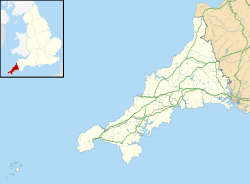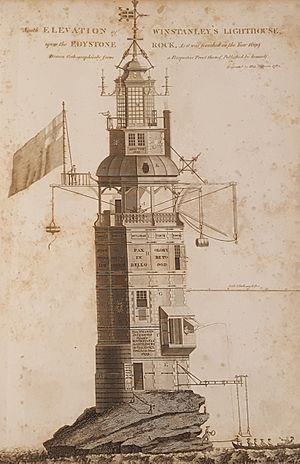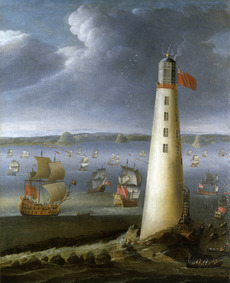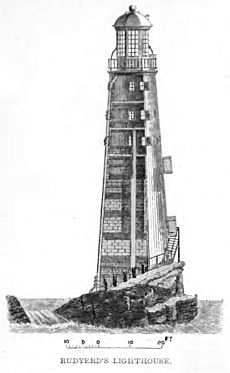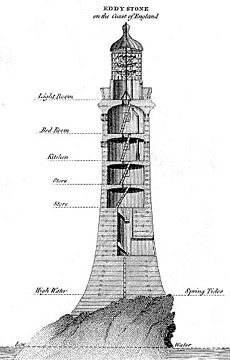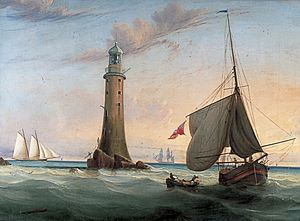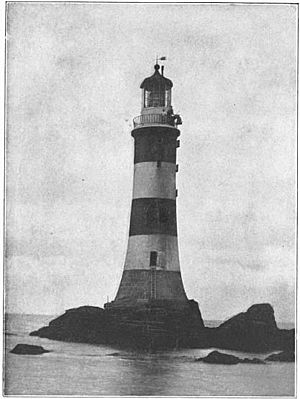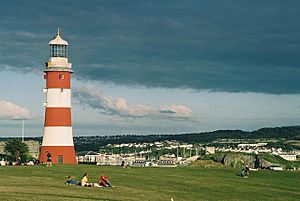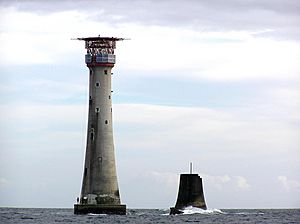Eddystone Lighthouse facts for kids
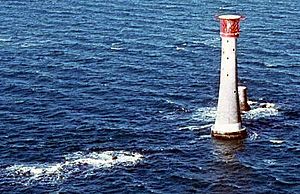 |
|
| An aerial view of the fourth lighthouse.
(The stub of the third lighthouse is visible in the background.) |
|
|
|
|
| Location | offshore Rame Head Plymouth England |
|---|---|
| Coordinates | 50°10′48″N 04°15′54″W / 50.18000°N 4.26500°W |
| Year first constructed | 1698 (first) 1709 (second) 1759 (third) |
| Year first lit | 1882 (current) |
| Automated | 1982 |
| Deactivated | 1703 (first) 1755 (second) 1877 (third) |
| Construction | wooden tower (first and second) granite tower (third and current) |
| Tower shape | octagonal tower (first) dodecagonal tower (second) tapered cylindrical tower (third) tapered cylindrical tower with lantern and helipad on the top (current) |
| Height | 18 metres (59 ft) (first) 21 metres (69 ft) (second) 22 metres (72 ft) (third) 49 metres (161 ft) (current) |
| Focal height | 41 metres (135 ft) |
| Current lens | 4th order 250 mm rotating |
| Intensity | 26,200 candela |
| Range | 17 nautical miles (31 km) |
| Characteristic | Fl (2) W 10s. Iso R 10s. at 28 metres (92 ft) focal height |
| Fog signal | one blast every 30s. |
| Admiralty number | A0098 |
| NGA number | 0132 |
| ARLHS number | ENG 039 |
The Eddystone Lighthouse is a famous lighthouse built on the dangerous Eddystone Rocks. These rocks are about 9 miles (14.5 km) south of Rame Head in England. Even though Rame Head is in Cornwall, the rocks themselves are hidden underwater and made of very old rock called gneiss.
The lighthouse you see today is the fourth one built in this spot. Some people even say it's the fifth, because the first one needed a lot of repairs after just one year. The first lighthouse was swept away in a huge storm, and its builder and five other men were lost. The second one lasted for 50 years before it caught fire. The third one, known as Smeaton's, is famous because it changed how lighthouses were designed. It also helped show how important concrete could be for building. The top part of this third lighthouse was moved and rebuilt in Plymouth as a monument. The very first Eddystone Lighthouse, finished in 1699, was the world's first lighthouse built far out in the open ocean.
Contents
Why a Light Was Needed
The Eddystone Rocks are a large group of underwater rocks about 12 miles (19 km) southwest of Plymouth Sound. This area was a very important naval harbour for England. The rocks are covered by water during high tides and were very scary for sailors entering the English Channel. To avoid them, ships often sailed closer to the coast of France. This led to many shipwrecks, not only near Eddystone but also on the French coast and the Channel Islands. It was very hard to even stand on these rocks because of the strong waves, so it took a long time before anyone tried to put a warning light there.
Winstanley's Lighthouse: The First Try

The first lighthouse on Eddystone Rocks was a wooden tower with eight sides. It was built by Henry Winstanley. This lighthouse was also the first time an offshore lighthouse was ever built. Construction began in 1696, and the light was turned on for the first time on November 14, 1698.
During the building, a French privateer (a kind of pirate) captured Winstanley and destroyed some of the work. But King Louis XIV of France ordered Winstanley to be set free. He said, "France is at war with England, not with humanity."
The lighthouse survived its first winter but needed repairs. It was then changed to have 12 sides with stone on the outside and a wooden frame inside. The top part, called the 'lantern', was 15 feet (4.6 m) high and 11 feet (3.4 m) wide. It had eight windows, each with 36 glass panes. The light came from 60 candles and a large hanging lamp.
Winstanley's tower lasted until a huge storm, called the Great Storm of 1703, hit on November 27. The storm completely destroyed the lighthouse. Winstanley was on the lighthouse, finishing some additions. No trace of him or the five other men inside the lighthouse was ever found.
Rudyard's Lighthouse: A Stronger Design
After the first lighthouse was destroyed, Captain John Lovett got the right to use the rock. An Act of Parliament allowed him to charge ships a small fee for passing by. He asked John Rudyard to design the new lighthouse.
Rudyard's lighthouse was different from the first one. It was a smooth, cone-shaped tower, built to resist strong winds and waves. It had a solid wooden base made of layers of timber beams. These beams were laid on seven flat steps cut into the rock. On top of this base were layers of stone mixed with more wood, which helped make the tower heavy and stable.
This lower part was 63 feet (19 m) high. Above it were four more levels made of timber. The whole structure was covered in vertical wooden planks, like a ship, and sealed to prevent water leaks. It was held to the rock with 36 iron bolts. The tower was topped with an eight-sided lantern, making it 92 feet (28 m) tall in total. The light was first turned on in July 1708, and the lighthouse was finished in 1709. It was lit by 24 candles. Rudyard's lighthouse was much stronger and lasted for almost 50 years.
In 1715, Captain Lovett passed away, and his lease was bought by Robert Weston and two others, including Rudyard.
On December 2, 1755, the top of the lantern caught fire. It was probably caused by a spark from one of the candles or a crack in the chimney from the kitchen below. The three keepers tried to put out the fire but had to escape to the rock. They were rescued by boat as the tower burned down. One keeper, Henry Hall, who was 94, sadly died a few days later. He had accidentally swallowed some melted lead from the lantern roof. A report about this was sent to the Royal Society, and the piece of lead is now in the National Museums of Scotland.
Smeaton's Lighthouse: A Design Breakthrough
The third lighthouse built on the Eddystone Rocks was a huge step forward in how lighthouses were designed.
How it Was Designed and Built
After Rudyard's tower burned down, Robert Weston asked the Earl of Macclesfield, who was the head of the Royal Society, for advice. He suggested John Smeaton, a talented engineer. Smeaton visited the rock in 1756 and suggested building the new lighthouse out of stone, shaped like an oak tree. He hired Josias Jessop as his assistant and set up a base on shore at Millbay for the building work.
Work on the rock began in August 1756. Workers carefully cut out spaces in the rock to fit the lighthouse's foundations perfectly. During the winter, they stayed on shore and prepared the stones. Work on the rock started again the next June, with the first layers of stone being laid. The foundations and outside were made of local Cornish granite. Lighter Portland limestone was used for the inside.
Smeaton also invented a special type of hydraulic lime (a kind of concrete) that could harden underwater. He also developed a way to connect the stone blocks using dovetail joints and marble pins. Building continued for two more years, and the light was first lit on October 16, 1759.
Smeaton's lighthouse was 59 feet (18 m) high. It was 26 feet (8 m) wide at the bottom and 17 feet (5 m) wide at the top. It was lit by 24 large tallow candles.
Later Changes
In 1807, the 100-year lease on the lighthouse ended, and Trinity House took over its ownership and management. In 1810, they replaced the candles with 24 Argand lamps and parabolic reflectors, which made the light much brighter.
In 1841, major repairs were made, including fixing the stone joints and filling a large hole in the rock near the base. In 1845, the lighthouse got a new, advanced second-order optic from Paris. This was the first time such a large and complete optic (using prisms) was used in any lighthouse. A new lantern was built and added to the top of the tower in 1848, as the old one wasn't good enough for the new lens.
From 1858, the tower was painted with wide red and white stripes. This made it easier to see during the day. In 1872, a large fog bell was added. It would ring five times quickly every half minute when it was foggy.
By 1877, reports said that the rocks under Smeaton's tower were eroding, causing the lighthouse to shake in big waves. So, it was decided to build a new lighthouse. While the new one was being built, the city of Plymouth asked if Smeaton's tower could be moved and rebuilt on Plymouth Hoe as a monument. Trinity House agreed to move the lantern and the top four rooms. The old lighthouse kept working until February 3, 1882. After the new tower was finished, Smeaton's lighthouse was taken apart.
Today
The upper part of Smeaton's lighthouse was rebuilt on a new granite base on Plymouth Hoe. It is kept there as a monument to Smeaton's amazing engineering skills. The public paid for the rebuilding. Today, it is called 'Smeaton's Tower' and is a popular tourist attraction.
The original base of the tower also still stands on the Eddystone Rocks, about 120 feet (37 m) from the current lighthouse. After the top part was moved, the old entrance and stairs were filled in. An iron mast was put on top of the remaining stub. This part of Smeaton's lighthouse still helps sailors by making the Eddystone Rocks easier to identify during the day.
Douglass's Lighthouse: The Current Tower
The lighthouse you see today is the fourth one. It was designed by James Nicholas Douglass, who used and improved on Smeaton's building methods. This lighthouse is still in use.
How it Was Designed and Built
By July 1878, the new site on the South Rock was being prepared. Workers could only work for about 3.5 hours between low and high tides. The first stone was laid on August 19, 1879, by Prince Alfred, who was the Master of Trinity House. The supply ship Hercules was based at Oreston, near Plymouth. The stone was prepared there and came from a company in Wadebridge.
The tower is 49 meters (161 ft) high and contains over 62,000 cubic feet of granite, weighing 4,668 tons. The last stone was laid on June 1, 1881, and the light was first turned on on May 18, 1882.
The lighthouse has a larger-than-usual lantern at the top, which is 16.5 feet (5 m) high and 14 feet (4.3 m) wide. The lantern is painted red. Inside was a huge, rotating optic with six sides and two levels. It was 12.5 feet (3.8 m) high and weighed over seven tons. Each side of the optic had two lens panels, which made the light flash twice every 30 seconds. This lens was made by Chance Brothers and designed by their chief engineer, John Hopkinson. At the time, the Eddystone's extra-tall lenses were the biggest ever made.
The light could be seen from 17 nautical miles (31 km) away. It was lit by two oil lamps, one for each level of the optic. On clear nights, only the lower lamp was lit, producing a light of 37,000 candlepower. But in poor visibility, both lamps were used at full power, creating a very bright 159,600 candlepower light. Eighteen tanks in the lower part of the tower could store enough colza oil to fuel the lamps for nine months.
Besides the main light, a steady white light shone from a window on the eighth floor. This light pointed towards the dangerous Hand Deeps area. The lighthouse also had two large bells, each weighing two tons, which served as a fog signal. They rang twice every 30 seconds in foggy weather, controlled by the same clockwork that turned the lenses. This mechanism needed to be wound every hour. Later, a small engine was added to help the keepers with this heavy task.
Later Changes
In 1894, an explosive fog signal was installed on the lighthouse gallery. The fog bells were kept for a short time as a backup but then removed. In 1904, the oil lamps were replaced with brighter incandescent oil vapour burners. Later, the lens system was upgraded to use a mercury bath, which made it easier for the optic to rotate.
In 1959, the light was changed to run on electricity. A smaller, fourth-order optic was installed, which flashed twice every 10 seconds, much faster than before. At the same time, a powerful supertyfon fog signal was added, powered by diesel generators. The old large optic was removed and given to the Southampton Maritime Museum.
The lighthouse became automated in 1982. It was the first offshore lighthouse managed by Trinity House to be automated. Two years before that, a helipad was built on top of the lantern. This allows maintenance crews to reach the lighthouse by helicopter. The helipad can hold up to 3,600 kg. When it was automated, a new electric fog signal was installed, and a metal halide discharge lamp replaced the old incandescent light bulb. The light and other systems were controlled remotely. Since 1999, the lighthouse has been powered by solar energy.
Today
The tower is 49 meters (161 ft) high. Its white light flashes twice every 10 seconds and can be seen up to 22 nautical miles (41 km) away. It also has a foghorn that sounds three blasts every 62 seconds. A special red light shines from a window in the tower to warn ships about the dangerous Hand Deeps to the west-northwest. Today, the lighthouse is monitored and controlled from the Trinity House Operations Control Centre in Harwich, Essex.
Tribute
On November 14, 2019, Google celebrated the 321st anniversary of the First Lighting of Eddystone Lighthouse with a special Google Doodle.
See also
 In Spanish: Faro de Eddystone para niños
In Spanish: Faro de Eddystone para niños


